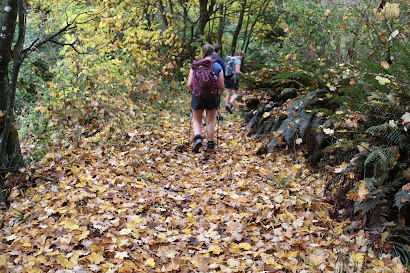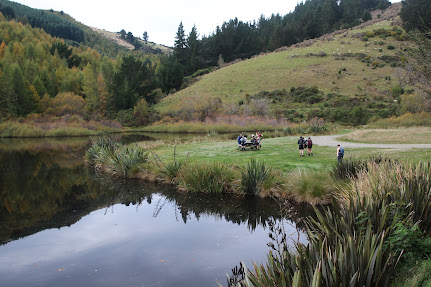The discovery of gold at Gabriels Gully in 1861 lead to the Central Otago goldrush. Dunedin almost emptied as 4000-5000 people rushed to Gabriels Gully in the first months to try their luck at finding gold and by the early 1900's the gold had gone and the area was deserted with most of the fortune hunters leaving broke. Today ten of us arrived in Gabriels Gully to not only explore and discover a little of it's history for ourselves but also to see some beautiful autumn colours that the area is popular for at this time of the year. We arrived at Greys Dam and were not disappointed as the lovely autumn colours were reflected in the mirror calm water of the dam. The Otago Dam was built early in the goldrush to provide water to Greys Dam which was used for the gold workings of Gabriels Gully. The track to Otago Dam skirts around the edge of Greys Dam before passing through a section of exotic trees wearing their magnificent autumn cloaks and covering the ground with a golden layer of crunchy leaves which we swished our way through. Once past this beautiful section we entered the native bush with easy walking for about 15 minutes before the first of six creek crossings. Each creek crossing is reasonably straightforward with large rocks marking convenient crossing points although the rocks can be slippery and require some careful foot placement to successfully negotiate with dry feet. The track climbs steeply in a couple of sections before flattening out and following an old water race. Following the old water race was easy walking and this was where we really started to notice the many mushrooms sprouting from the forest floor. There were all colours of mushrooms from black to dark brown, caramel, cream, white, yellow, red, orange and of course red with white spots. There were mushrooms with pointy tops, rounded tops and flat tops. They ranged in size from pin heads up to dinner plate sized. Some mushrooms were well camouflaged while others proudly wore their bright colours. It became a game of spotting the fungi with some clinging to trees, sheltered under muddy banks, hiding behind foliage or simply growing on the track. The sheer variety and number of mushrooms was amazing. After an hour of walking we skirted around the edge of a pine forest before arriving at the Otago Dam. The dam itself is nondescript as it is surrounded by native bush and pine forest but it does give a good sense of the height gained from Greys Dam The sheltered site of the dam meant the water was calm giving wonderful reflections and an air of peace as it is rarely visited. We stopped for a snack break and there was some talk about how deep the dark waters of the dam might be but no one was game to test the depth.
The Otago Dam was our end destination so after morning tea and rest we retraced our way down the sometimes, muddy track and again marveled at the variety of mushrooms. This was a mushroom lovers paradise and while we came to see the autumn leaves, the mushrooms stole the show! We followed the water race around the side of the valley, taking the time to appreciate the work that had gone into building it 150 years ago and all of it still in tact. The track did not seem as long on the return journey and the creek crossings were again successfully negotiated with dry feet. The creek is picturesque with the water flowing past the rocks, overshadowed by moss and ferns as it winds it's way towards Greys Dam. The 6.1 km walk to Otago Dam is only an hour each way and is well worth the time, especially at this time of year. Once back at Greys Dam, it was time for lunch and with our group the only people in the area, we enjoyed the peace, the autumn colours and reflections.
After lunch the plan was to walk the Gabriels Gully loop which is an easy 1.5 hour loop track that circles around the outer edge of Gabriels Gully, following old water races and giving a good views into the gully itself. The track starts off climbing steeply, gaining 120m in height before flattening out once we reached the old water race. We followed the water race to Pollards Dam which no longer holds water but is a great place for autumn leaves. After visiting Pollards Dam we continued following the water race and stopped to inspect the Racemans Cottage site before moving onto the Blue Spur lookout which gave us panoramic views of the surrounding hills including down into the valley floor where hundreds of tents once housed the miners and over to the remnant stacks of conglomerate (gold bearing) rock. A bit further on we discovered the remains of the North of Ireland stamper battery where we tried to imagine the work involved in keeping the stamping battery operating along with the noise the stampers made echoing off the valley walls. After walking through regenerating forest, we passed the Great Extended Mine shaft before following the track down the hill and back to the car park.













